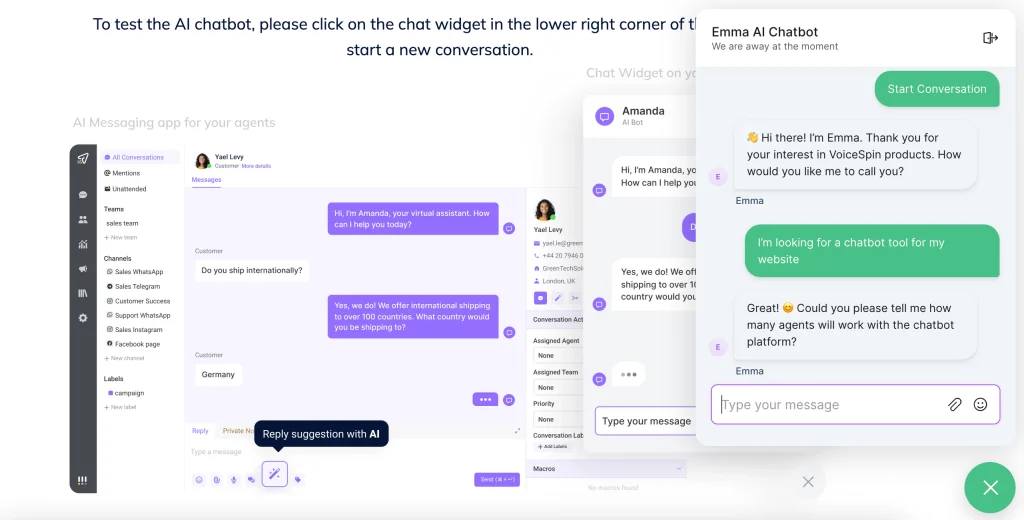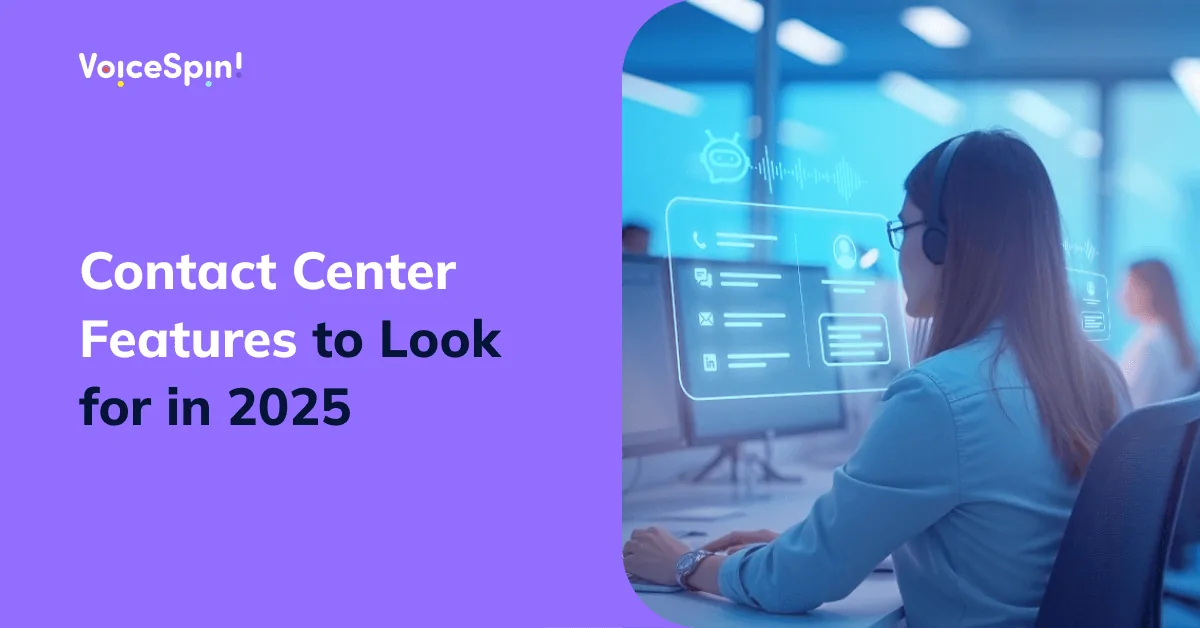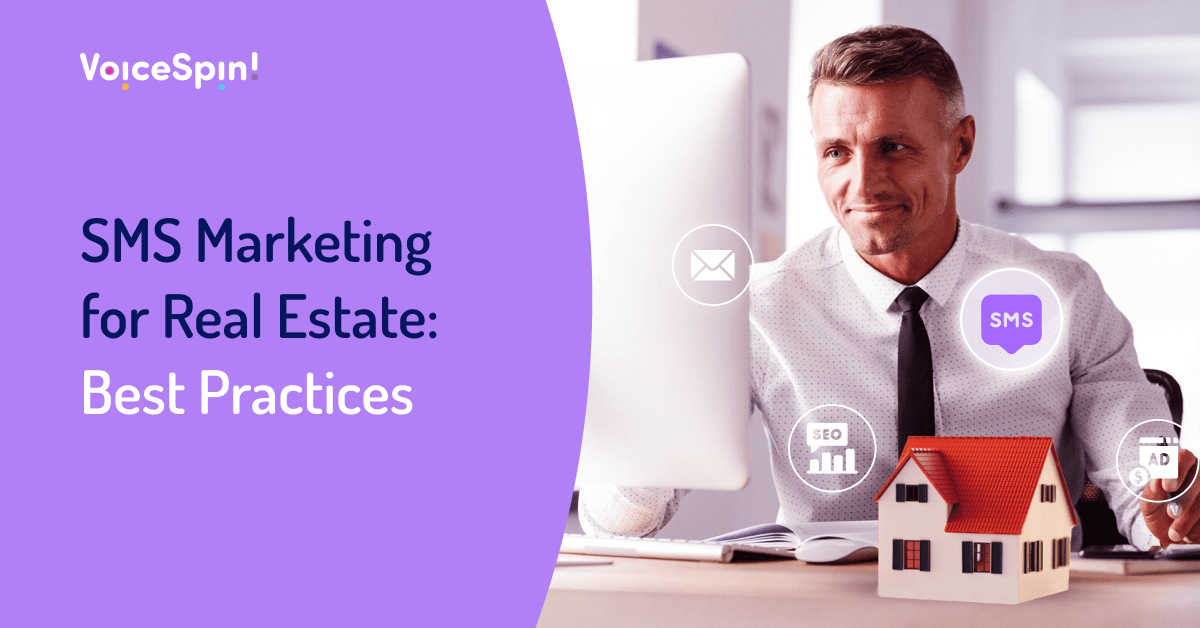Outbound sales isn’t dead – it’s just evolving and getting smarter with AI. But if you’re not getting the results you aim for, you’re probably doing it wrong in 2025. On top of razor-sharp targeting, hyper-personalization, and consistent follow-ups (all of which are still incredibly important), your sales reps must be equipped with the right AI-powered sales tack stack.
In fact, with AI, you can literally optimize every step of your sales process and automate a bunch of tasks that once had to be done manually, making your sales team faster and more efficient. Let’s cut through the noise and take a closer look at the top AI sales tools your outbound call center team needs in 2025 and beyond.
What is a Sales Tech Stack?
A sales tech stack (or a sales technology stack) is a collection of software tools that support the entire sales cycle – from lead generation and outreach to follow-ups and analytics. It typically includes lead prospecting tools, email automation platforms, outbound dialers, CRM systems, analytics solutions, sales productivity tools, and more. This is basically what your sales team needs to work smarter, move prospects faster through the sales pipeline, close more deals, and ultimately drive more revenue growth for your business. In this blog, we’ll be talking about sales tools that are critical for outbound call center teams, in particular.
Must-Have Tools for Outbound Call Centers to Enhance Your Sales Tech Stack
Sales prospecting software
Sales prospecting software tools top our list because they are at the forefront of a successful outreach strategy. Outbound call centers can leverage these solutions to quickly find and qualify potential leads based on multiple criteria like industry, company size, or buying signals, saving hours of manual research.
And they don’t just provide a pool of verified contacts to reach out to. They help you ensure you connect with the right prospects, at the right time, with the right (personalized) message so you can scale your outreach efforts more strategically.
Some of the top sales prospecting software tools that are worth your attention:
- Cognism: provides high-quality, GDPR-compliant data to help sales leaders reach out to prospects they want to do business with. You can use it to gain accurate contact details (business emails and mobile phone numbers) of decision-makers in the US, EMEA, and APAC.
- ZoomInfo: a leading sales prospecting software known for its extensive B2B database of company profiles and contact data. It allows you to find and connect with potential customers based on various criteria like industry, company size, job title, and location.
- Octopus CRM: a powerful lead generation software that can streamline the process of prospecting and lead generation. The tool can extract information from LinkedIn and automate outreach by sending LinkedIn connection requests and messages in bulk.
- Lusha: a B2B sales intelligence and prospecting tool that offers a Chrome extension, a contact list builder, data enrichment, and native CRM integrations. Sales reps can use it to find their prospect’s direct contact information in just a few clicks.
- Seamless.AI: a B2B prospecting software solution that uses AI and machine learning to research and validate the emails and phone numbers of professionals. You can also use it to determine your buyer’s needs and shape the right messaging before reaching out.
Predictive dialer software
When it comes to outbound call centers, auto dialers are essential. These tools eliminate the need to dial numbers manually, saving sales reps a great deal of time and effort when running outbound calling campaigns. But let’s take a deeper dive into predictive dialers, in particular. Unlike power dialers that call numbers one by one, these solutions dial multiple numbers per agent at once while agents are still on a call and connect them only when a live person answers.
Predictive dialers automatically adjust the dialing rate while trying to ‘predict’ each rep’s availability based on multiple real-time and historical metrics (like the average call duration, call answer rate, call abandonment rate, and the number of available reps). That means as soon as an agent completes their current interaction, they are instantly connected to the next call.
If you aren’t using it yet, here’s why a predictive dialer is a must-have tool for outbound call center teams:
- Sales reps can handle more calls in less time: Agents can handle more outbound calls – and they don’t have to wait for the calls to connect because predictive dialers can automatically skip answering machines, busy signals, and disconnected numbers.
- Reduces idle time and increases talk time: Since reps are instantly connected to the next answered call as soon as the previous call is over, there is no idle time in between calls and more talk time per agent.
- Higher call answer rates with local caller ID: With the ability to display numbers with local area codes, predictive dialers can help improve call answer rates, as people are nearly four times more likely to answer unknown calls from local numbers, according to a survey from Software Advice.
- Better outreach with automated voicemail drop: With an automated voicemail drop feature, predictive dialers can automatically leave pre-recorded voicemail messages, allowing you to reach those prospects who don’t answer phone calls.
- Improves compliance management: Built-in compliance features of predictive dialers (like Do Not Call list filtering, call time restrictions, and consent tracking) can help you stay compliant when running cold calling campaigns and avoid costly fines.
VoiceSpin’s AI predictive dialer is an excellent example – and it goes beyond what typical predictive dialers offer. Its AI and machine learning algorithms can intelligently score your leads and connect them to the best-suited sales reps based on the probability of a successful call outcome, helping you increase the efficiency of your outbound calling campaigns and maximize conversions.
Recommended reading: 5 Best Predictive Dialer Software for 2025
AI voice bot/ AI voice agent
While outbound dialers can automate the dialing part, AI voice bots (AI voice agents, AI calling bots, or whatever you call them) can automate the entire process of initiating and handling outbound calls. Imagine a virtual sales agent that reaches out to your prospects and interacts with them just like a human – confident, knowledgeable, and capable of representing your business like a seasoned sales pro. That’s what modern AI voice agents can already do – and VoiceSpin’s AI voice bot is a great example.
Of course, these solutions are still an emerging technology. In fact, most AI voice agents available on the market today are actually only able to respond to incoming calls and handle basic customer service interactions. Very few solutions out there can initiate and handle outbound calls on their own, but with demand skyrocketing, we’re likely to see many more emerge soon. So, here’s what some of the most advanced AI calling bots are capable of:
- Initiate and handle cold sales calls: Cold calling has always been the least favorite task for sales reps. Fortunately, AI voice bots can now automate this process and engage with cold leads without involving your human reps.
- Qualify leads and capture lead information: AI voice bots can take care of the initial lead qualification by asking prospects pre-qualification questions, gauging their intent to buy, accurately capturing their information, and saving it directly to your CRM.
- Schedule demo calls with sales reps: Beyond simply providing relevant information about your products, services, or offerings, AI voice agents can connect to calendar apps and schedule demo calls/ meetings with your sales reps.
- Perform specific actions in the integrated systems: Apart from CRM and calendar apps, AI voice agents can integrate with other back-end systems through APIs and perform specific actions within those systems – all without requiring human assistance.
- Seamlessly transfer conversations to human reps: While AI voice bots can handle simple conversations on their own, they can also seamlessly transfer calls to human sales reps when needed while providing reps with full context of the interaction.
AI speech analytics software
AI speech analytics isn’t just a ‘nice-to-have’‘ tool in your outbound call center tech stack. And here’s why. These solutions can monitor 100% of your outbound calls (instead of you having to screen a random sample of calls manually), transcribe, and summarize every single conversation. Most importantly, they can help you extract valuable insights from every call that you can use to better adjust your strategy. VoiceSpin’s AI Speech Analyzer allows you to do just that and more.
Here’s what AI speech analytics tools can help you with:
- Automate performance monitoring and spot training gaps: Speech analytics software can help you stay on top of your team’s performance, identify top-performing sales reps, what they say differently compared to low performers, and where additional training is needed.
- Track customer sentiment and reveal common objections: With speech analytics tools, you can monitor sentiment and understand how your prospects feel during interactions with your sales reps. Better yet, you can reveal the most common objections and train your reps to handle them effectively.
- Identify bottlenecks or drop-off points in the sales funnel: Speech analytics solutions can help you detect where your prospects disengage during calls (intro, pitch, pricing, closing), revealing common friction points so you can better adjust your scripts and improve objection handling.
- Monitor compliance during sales calls: Last but not less important, AI speech analytics software can track specific keywords and phrases your sales reps use during calls in real time so you can monitor whether they follow compliance guidelines.
Interactive demo software
These solutions are becoming increasingly popular, especially among teams selling complex products or SaaS solutions – and that makes perfect sense. Instead of doing demos the traditional way and relying on static slides and verbal explanations, interactive demo platforms allow sales reps to share live, clickable product demos while prospects are on the phone.
That helps transform static sales pitches into collaborative visual experiences and keep prospects engaged. You can guide them through actual product workflows, show real-time use cases, and address objections with visual proof. And that can be a game-changer for your conversion rates.
Here are some top interactive demo software platforms to consider in 2025:
- Storylane: an agentic demo automation platform that enables sales reps to create interactive product demos in minutes by capturing the front end of the software through the screen capture feature and auto-generating demo content and voiceovers with AI.
- Navattic: no-code interactive product demo software that lets you build and share interactive demos that can be embedded on websites, shared into sales cycles, used for in-product onboarding, or included in email and ad campaigns.
- Walnut: a codeless demo automation solution that can help your sales team create customizable, reusable, and interactive product demos tailored to each prospect’s use case to provide a unique experience.
AI-powered Customer Relationship Management (CRM) platform
A Customer Relationship Management platform is a foundational tool for sales and marketing teams. Nearly 70% of salespeople say using a CRM system is “very important” for closing deals, according to the LinkedIn State of Sales Report. That’s because CRM platforms come with a ton of features and capabilities that can help sales reps automate workflows, keep track of customer data, manage and prioritize leads, track performance, and do so much more. And with built-in AI tools and features, CRM systems have become even more powerful.
Here’s why a CRM system is vital for outbound call center teams:
- Centralizes all customer data in one place: A CRM system serves as a single source of truth for all customer information, giving sales reps instant access to interaction history, previous purchases, and preferences so they can better personalize interactions.
- Integrates with call center tools: CRM platforms can integrate with call center tools and auto dialers, enabling agents to initiate outbound calls and run outbound calling campaigns right from the CRM interface with no need to switch between multiple tools.
- Helps with lead management and segmentation: In a CRM system, sales reps can easily organize leads by status, segment prospects based on criteria like location or behavior, and prioritize high-potential opportunities.
- Automates lots of repetitive tasks for sales reps: Things like logging call outcomes, sending follow-up emails, and scheduling follow-up calls can all be automated in a CRM system, giving reps more time to focus on building relationships and selling.
- Helps with performance tracking and analytics: With CRM reporting tools, sales reps can always stay on top of sales activities, campaign effectiveness, conversion rates, and more to adjust strategies for better outcomes.
Top 5 AI-powered CRM platforms for modern sales teams that are worth exploring:
- HubSpot: Offers a free version, best option for small businesses
- Pipedrive: Offers AI agents, an AI email generator, and other AI tools
- Zoho CRM: Offers an AI sales assistant and AI-powered predictions
- Salesforce: Offers chatbots, predictive analytics, and gen AI capabilities
- Monday CRM: Offers AI-powered automation and AI reporting and insights
Recommended reading: Best CRM Systems for Sales Reps in 2025
Sales automation and email marketing software
This is a pretty broad category that includes a wide range of tools and platforms that allow you to send automated personalized email sequences to hundreds or thousands of leads without manual effort, so your sales reps can reach prospects on digital channels beyond phone. These tools enable targeted communication based on prospect behavior, demographics, funnel stage, or other criteria, while analytics features give you visibility into what messaging works, when prospects engage, and which email sequences drive better results.
Top 5 sales automation and email marketing software platforms worth your attention:
- Salesloft: a sales engagement platform that helps sales reps improve outreach and deal closing rates with automated email sequences, call tracking, and cadences. It’s popular among B2B sales teams for outbound outreach and pipeline acceleration.
- Yesware: a sales automation and productivity platform that can help sales teams track emails, schedule meetings, and automate outreach directly from their inbox. It offers features like email templates, campaign tracking, and real-time engagement analytics.
- ActiveCampaign: combines email marketing, sales automation, and CRM functionality in one tool. It enables you to create personalized email campaigns, automate follow-ups, and manage leads through advanced workflows.
- Brevo: an all-in-one marketing and CRM platform that offers email marketing, SMS campaigns, marketing automation, and sales pipeline management tools. It allows you to run automated marketing campaigns through email, SMS, and WhatsApp.
- Dripify: a sales automation tool designed to automate LinkedIn outreach and email marketing campaigns. It lets you create automated, hyper-personalized outreach sequences, manage leads, and analyze campaign performance.
Add VoiceSpin’s AI Contact Center Solutions to Your Sales Tech Stack to Speed up Your Sales Processes

With a robust sales tech stack, your sales reps can automate a bunch of manual processes, reach out to more leads in a shorter time, convert prospects more effectively, and hit their sales targets faster. And with AI in the mix, your sales team’s efficiency can improve dramatically. So, if you’re running an outbound call center, here’s how VoiceSpin’s AI contact center solutions can help your sales reps work smarter:
✓ AI predictive dialer
VoiceSpin’s AI-powered predictive dialer is truly one of the most advanced outbound dialers on the market. It can intelligently score your leads and connect them to the best-suited sales reps to help you improve conversions when running outbound calling campaigns. Plus, features like local caller ID, automated voicemail drop, DNC list filtering, and number reputation management make it an ideal solution for high volume outbound calling.
✓ AI voice bot/ voice agent
Our AI voice bot is more than just a customer service automation tool that handles inbound calls independently. You can connect it to VoiceSpin’s AI dialer and automate outbound cold calls, lead nurturing campaigns, reminders, and follow-ups. The bot can be trained on your own data using a RAG (Retrieval-Augmented Generation) model; it speaks multiple languages, and can handle hundreds of calls simultaneously, so you can scale your outreach efforts without having to expand your sales team.
✓ AI speech analytics
VoiceSpin’s AI Speech Analyzer can help you automate your call center QA and performance monitoring processes. It can monitor and analyze 100% of your sales calls, evaluate the quality of interactions and your sales team’s performance based on your custom metrics and KPIs, and help you prevent non-compliance issues through keyword detection and real-time manager alerts.
✓ Omnichannel messaging
Our AI Messaging platform allows you to integrate multiple digital communication channels (including email, SMS, social media, WhatsApp, and other instant messaging apps) in one omnichannel inbox. In addition to responding to inbound messages, you can use it to send outbound campaigns and reach out to your prospects proactively.
Schedule a demo call now to see VoiceSpin’s AI contact center solutions in action and how they can enhance your outbound sales team’s tech stack, helping your reps sell smarter and faster.
Frequently Asked Questions
Why do I need a sales tech stack?
A sales tech stack gives you all the software tools you need to sell faster, smarter, and more effectively. These tools can help you automate multiple repetitive tasks (saving you a bunch of time and effort), speed up outreach, improve lead targeting, personalize interactions, and get visibility into your sales pipeline. With the right sales tech stack, you can spend more time building relationships with prospects and actually selling instead of doing admin work.
How many tools should I have in my sales tech stack?
There’s no one-size-fits-all answer, but most sales organizations use around 10 software tools. The number of tools you’ll need in your sales tech stack ultimately depends on factors like the size of your business, the complexity of your product or service, the length of your sales cycle, and your budget. What matters most isn’t how many tools you have, but whether they genuinely help your sales process and make things easier for your team.
What are the must-have tools in a sales tech stack in outbound call centers?
Since outbound call centers revolve around phone outreach, having reliable call center software with an outbound dialer is foundational. But if you want to fully automate the outbound calling process – not just the dialing part – consider adding an AI voice bot that can initiate and manage calls on its own, promote your products or services, qualify leads, book demos, and handle other tasks. And, of course, a CRM system is a must to keep all your customer data organized and easily accessible.





 +18889082995
+18889082995
 +442036084160
+442036084160
 +97237237006
+97237237006